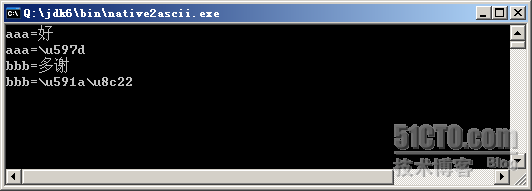一、认识国际化资源文件
这个类提供软件国际化的捷径。通过此类,可以使您所编写的程序可以:
轻松地本地化或翻译成不同的语言
一次处理多个语言环境
以后可以轻松地进行修改,支持更多的语言环境
说的简单点,这个类的作用就是读取资源属性文件(properties),然后根据.properties文件的名称信息(本地化信息),匹配当前系统的国别语言信息(也可以程序指定),然后获取相应的properties文件的内容。
使用这个类,要注意的一点是,这个properties文件的名字是有规范的:一般的命名规范是: 自定义名_语言代码_国别代码.properties,
如果是默认的,直接写为:自定义名.properties
比如:
myres_en_US.properties
myres_zh_CN.properties
myres.properties
当在中文操作系统下,如果myres_zh_CN.properties、myres.properties两个文件都存在,则优先会使用myres_zh_CN.properties,当myres_zh_CN.properties不存在时候,会使用默认的myres.properties。
没有提供语言和地区的资源文件是系统默认的资源文件。
资源文件都必须是ISO-8859-1编码,因此,对于所有非西方语系的处理,都必须先将之转换为Java Unicode Escape格式。转换方法是通过JDK自带的工具native2ascii.
二、实例
定义三个资源文件,放到src的根目录下面(必须这样,或者你放到自己配置的calsspath下面。
#myres.properties
aaa=good
bbb=thanks
#myres_en_US.properties
aaa=good
bbb=thanks
#myres_zh_CN.properties
aaa=\u597d
bbb=\u591a\u8c22importjava.util.Locale;importjava.util.ResourceBundle;/*** 国际化资源绑定测试
*
*@authorleizhimin 2009-7-29 21:17:42*/
public classTestResourceBundle {public static voidmain(String[] args) {
Locale locale1= new Locale("zh", "CN");
ResourceBundle resb1= ResourceBundle.getBundle("myres", locale1);
System.out.println(resb1.getString("aaa"));
ResourceBundle resb2= ResourceBundle.getBundle("myres", Locale.getDefault());
System.out.println(resb1.getString("aaa"));
Locale locale3= new Locale("en", "US");
ResourceBundle resb3= ResourceBundle.getBundle("myres", locale3);
System.out.println(resb3.getString("aaa"));
}
}
#运行结果
好
好
good
Process finished with exit code0
四、中文资源文件的转码 native2ascii

如果觉得麻烦,可以直接将中文粘贴到里面,回车就可以看到转码后的结果了。
















最基础的部分)

低于或等于10万元时,奖金可提10%_java企业利润提成计算代码...)

